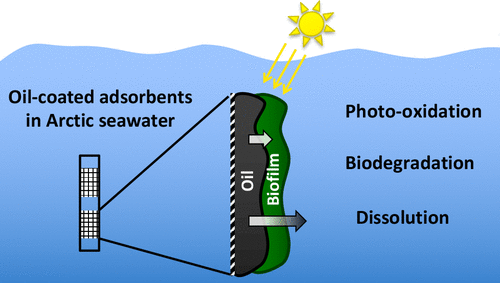当前位置:
X-MOL 学术
›
Environ. Sci. Technol.
›
论文详情
Our official English website, www.x-mol.net, welcomes your feedback! (Note: you will need to create a separate account there.)
Biodegradation, Photo-oxidation, and Dissolution of Petroleum Compounds in an Arctic Fjord during Summer
Environmental Science & Technology ( IF 10.8 ) Pub Date : 2019-10-15 , DOI: 10.1021/acs.est.9b03336 Leendert Vergeynst , Charles W. Greer 1 , Anders Mosbech , Kim Gustavson , Lorenz Meire 2, 3 , Kristoffer G. Poulsen 4 , Jan H. Christensen 4
Environmental Science & Technology ( IF 10.8 ) Pub Date : 2019-10-15 , DOI: 10.1021/acs.est.9b03336 Leendert Vergeynst , Charles W. Greer 1 , Anders Mosbech , Kim Gustavson , Lorenz Meire 2, 3 , Kristoffer G. Poulsen 4 , Jan H. Christensen 4
Affiliation

|
Increased economic activity in the Arctic may increase the risk of oil spills. Yet, little is known about the degradation of oil spills by solar radiation and the impact of nutrient limitation on oil biodegradation under Arctic conditions. We deployed adsorbents coated with thin oil films for up to 4 months in a fjord in SW Greenland to simulate and investigate in situ biodegradation and photo-oxidation of dispersed oil droplets. Oil compound depletion by dissolution, biodegradation, and photo-oxidation was untangled by gas chromatography–mass spectrometry-based oil fingerprinting. Biodegradation was limited by low nutrient concentrations, reaching 97% removal of nC13–26-alkanes only after 112 days. Sequencing of bacterial DNA showed the slow development of a bacterial biofilm on the oil films predominated by the known oil degrading bacteria Oleispira, Alkanindiges and Cycloclasticus. These taxa could be related to biodegradation of shorter-chain (≤C26) alkanes, longer-chain (≥C16) and branched alkanes, and polycyclic aromatic compounds (PACs), respectively. The combination of biodegradation, dissolution, and photo-oxidation depleted most PACs at substantially faster rates than the biodegradation of alkanes. In Arctic fjords during summer, nutrient limitation may severely delay oil biodegradation, but in the photic zone, photolytic transformation of PACs may play an important role.
中文翻译:

夏季北极峡湾中石油化合物的生物降解,光氧化和溶解
北极地区经济活动的增加可能会增加漏油的风险。然而,对于北极辐射条件下溢油的降解以及养分限制对石油生物降解的影响知之甚少。我们在格陵兰西南部的峡湾中部署了覆盖了油膜的吸附剂长达4个月,以模拟和研究分散油滴的原位生物降解和光氧化作用。气相色谱-质谱联用的油指纹图谱分析了由于溶解,生物降解和光氧化作用而导致的油化合物消耗减少的情况。生物降解受到营养物浓度低的限制,n C 13–26的去除率达到97%-烷烃仅在112天后才能使用。细菌DNA的测序显示上通过公知的油降解菌为主的油膜细菌生物膜发展缓慢Oleispira,Alkanindiges和Cycloclasticus。这些类群可能与较短链的生物降解(≤C 26()烷烃,长链≥C 16),支链烷烃和多环芳族化合物(PAC)。生物降解,溶解和光氧化的结合使大多数PAC的消耗速度比烷烃的生物降解快得多。在夏季的北极峡湾中,养分限制可能会严重延迟石油的生物降解,但是在光合作用区,PAC的光解转化可能起重要作用。
更新日期:2019-10-16
中文翻译:

夏季北极峡湾中石油化合物的生物降解,光氧化和溶解
北极地区经济活动的增加可能会增加漏油的风险。然而,对于北极辐射条件下溢油的降解以及养分限制对石油生物降解的影响知之甚少。我们在格陵兰西南部的峡湾中部署了覆盖了油膜的吸附剂长达4个月,以模拟和研究分散油滴的原位生物降解和光氧化作用。气相色谱-质谱联用的油指纹图谱分析了由于溶解,生物降解和光氧化作用而导致的油化合物消耗减少的情况。生物降解受到营养物浓度低的限制,n C 13–26的去除率达到97%-烷烃仅在112天后才能使用。细菌DNA的测序显示上通过公知的油降解菌为主的油膜细菌生物膜发展缓慢Oleispira,Alkanindiges和Cycloclasticus。这些类群可能与较短链的生物降解(≤C 26()烷烃,长链≥C 16),支链烷烃和多环芳族化合物(PAC)。生物降解,溶解和光氧化的结合使大多数PAC的消耗速度比烷烃的生物降解快得多。在夏季的北极峡湾中,养分限制可能会严重延迟石油的生物降解,但是在光合作用区,PAC的光解转化可能起重要作用。







































 京公网安备 11010802027423号
京公网安备 11010802027423号